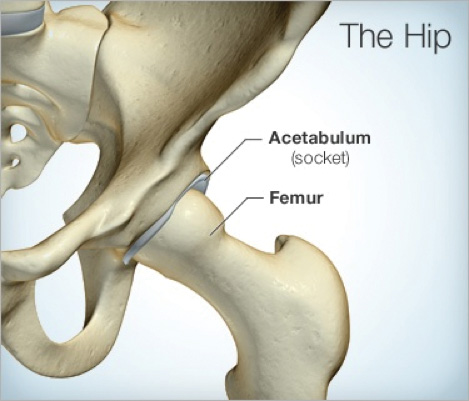Your hip is the joint where your thigh bone meets your pelvis. It is called a ball-and-socket joint, because the ball-like top of your thigh bone (femur) fits into a cup-like area (acetabulum) within your pelvis, much like a baseball fits into a glove. The labrum is a rim of soft tissue or fibrocartilage that surrounds the acetabulum (hip socket). The labrum adds to the stability of the hip by deepening the socket and protecting the joint surface.
Normally, the ball glides smoothly within the socket, but a problem with the ball or socket rim can interfere with smooth motion. This problem can cause femoroacetabular impingement also referred to as hip impingement.
The main symptoms are stiffness in the groin or front of the thigh and/or a loss of your hip's full range of motion. At first, you may only feel pain when you move the hip near its limits. As the condition progresses, however, you may feel pain with more subtle activities, such as sitting for a long time or walking up a hill. Pain that occurs at night or when walking on flat ground suggests that the cartilage cushioning the ball and socket has begun to break down and wear away, a condition known as osteoarthritis.
Treatment for hip impingement starts with conservative measures such as rest, activity modification, physical therapy and the use of anti-inflammatory medications. Diagnosis and need for surgery will be based on the description of your symptoms, a physical exam, response to conservative treatments, and the findings of imaging tests such as an x-ray, MRI or CT scan. Hip arthroscopy can be used for the diagnosis of unexplained hip pain or commonly for the treatment of hip impingement and its associated conditions such as labral tears and cartilage abnormalities.

Hip arthroscopy refers to the viewing of the interior of the hip joint through an arthroscope using 2-4 very small incisions, each approximately ½” in length. The procedure is performed under general anesthesia as an outpatient. The procedure can take 2-3 hours. The arthroscope allows the physician to see inside the hip joint, diagnose and possibly correct any conditions he may find. If the affected hip has minimal cartilage damage, the surgeon may use tools to reshape the ball and/or the outside edge of the socket that is catching on the thigh bone. Conditions such as labral tears require a more extensive technique allowing the labrum to be reattached to the acetabulum (socket).
Once you are awake and taking fluids, the IV will be removed and you will be allowed to go home.
You will have pre-admission testing done before your surgery to ensure that you are healthy enough for the planned procedure. Testing may include lab work, an EKG and a chest x-ray. Medications that increase your risk for bleeding should be stopped prior to surgery. Your medication list will be reviewed with one of our nurses and you will be advised as to which medications need to be stopped and when. Prescription blood thinners can only be stopped under the approval of the physician who is prescribing them for you. Our nurse will provide you with a prescription for crutches or a walker for use after surgery. Please bring either crutches or a walker with you the day of surgery.
Corrective repairs that may have been performed during the arthroscopy will require you to be non-weight bearing for 3 weeks following the procedure. This will require strict use of crutches or a walker for 3 weeks to allow the repairs to heal. Your physician will advise you about your weight bearing status before you go home.
If you have a labor intensive job that includes heavy lifting, squatting or running, you may have restrictions for up to 3 months after your surgery.
It is normal to experience mild swelling around the hip, pain around the incisions or stiffness in your hip after arthroscopic surgery.
Physical therapy typically starts 1-2 weeks after surgery and will continue for several months.
For additional information about this procedure, including what to do to prepare for your surgery and at-home instructions, we have included this complete patient eduction sheet as a pdf to view, download and print: